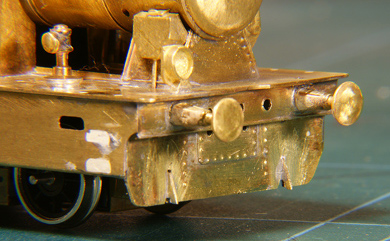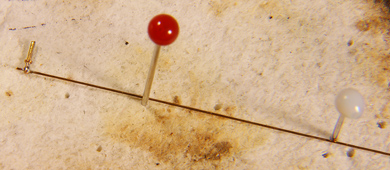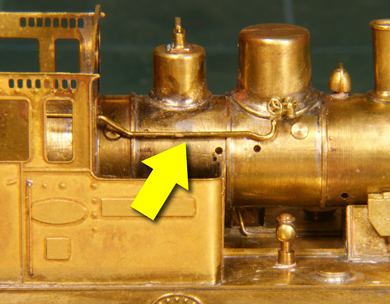Garrattfan's Modelrailroading Pages

SHM 26
Final detailing
After an ample pause to attend other more pressing family matters I picked up modelling the SHM26 again in February 2015. As always when a project is drawing to an end there are many small jobs to be performed. Almost every project seems to be suffering from the "80 % syndrome". The loco's main features are done but much work is still lingering in the box, much more than to justify the "almost finished" status.
When I picked up the loco again I intended to really, really, really finish this almost finished loco within say a week. Well, no sursprise that was just a tad more than I expected ;-) No problem of course, after all that is what model building is all about: the work.
 |
 |
First I added the buffers and the headlamps on the front and the rear.
SHM26's buffers are the open type buffers where the coil spring is visible from the top and bottom sides. The buffers as supplied have four open sides. Note that I closed the left and right sides with putty. The buffers have only the support of the buffer bar so I expected them to go in any direction before sitting straight, but thanks to a bout of extreme patience and inner peace they went on pretty well.
|
|
 |
 |
Water tank lids added
|
|
 |
 |
Handrails added
|
|
 |
I used this bending jig. Well worth the investment. Once you have the right size, every other handrail of the same size is repeatable over and over again. Saves a lot of time and usually also some material. |
 |
I had two track cleaners in the original kit. But when I started completing the loco I could find only just one. I soldered it to a sheet of brass, sawed and filed it to size, cut two folding lines and tadaaah, I had two again. |
 |
 |
I used the old skirts to mark the place of the slitswhich where cut out with a disc cutter.
Yeah, I admit having forgotten to make these slits before soldering the skits in place. That would have been far easier.
|
|
 |
 |
The track cleaners soldered in place
|
|
 |
Air hose added |
 |
 |
There are some handrails left to do. I have learned from other models that handrails once punt in place
The latter could be a matter of finding the right paint. For all reasons I have decided to add them at the latest possible stage of construction of this loco. I assembled them to size before painting. Then I chemically blacken them (if needed) so I won't have to paint them. I will add them with a tiny spot of epoxy after painting the loco only after everything else has been done.
|
|
 |
The handrail knobs and wire for the rear are extremely delicate. Just 0.3 mm wire (normal is 0.5 mm) |
 |
 |
 |
The feed water pipe was a nuisance to bend. The 0.7mm thick brass rod was not the most cooperative and it had to be bend in all three dimensions with only small tolerances. The tight bend under the clack valve didn't make it any easier. |
 |
 |
| The free standing handrails on the front on the front of the prototype have a metal sheen, so the natural thing to do is use nickel silver. I soon found that it bent at every touch and its exposed position made it prone to touching. So I replaced it with phosphor bronze wire which is very springy. | |
 |
And finally I added two handrails and the handwheels to the smokebox door. The handwheel is not entirely correct but the one supplied with the kit went MIA. |


Sign my
GuestBook